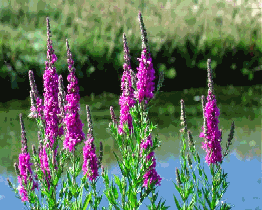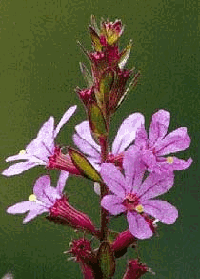Purple Loosestrife

INTRODUCTION: An invasive plant species -- purple loosestrife -- is taking up residence in Jackson. It has been spotted along the Wildcat at Eagle Mountain and close to the park as well as in private gardens. This is an invasive plant species and should be removed from where it is found and not used for garden plantings. Unfortunately, characteristics that make the plant a formidable invader -- hardiness, tolerance of many moisture and nutrient regimes, and virtual freedom from insect pests and disease -- also have made this plant an attractive garden perennial. Southern Living magazine stated, "Loosestrife is a perennial every garden needs. It's stunning in leaf and flower, and grows just about everywhere."
THE PROBLEM: However, purple loosestrife (Lythrum salicaria) is an aggressive invader of North American wetlands, lakes and rivers. Once established, purple loosestrife can become the dominant vegetation, forming monospecific stands which significantly reduce biodiversity and degrade habitat quality. Of primary concern is that purple loosestrife displaces native plants eliminating food and shelter for wildlife and other species. While strikingly colorful in flower, dense stands of loosestrife also impair recreational use of wetlands and rivers, impede water flow in drainage ditches and invade right-of-ways, requiring costly management efforts. Purple loosestrife is a widespread and serious problem, affecting both coastal and inland wetlands, lakes and waterways.
 REMOVAL: The best way to remove purple loosestrife is by hand digging. Make sure that all pieces of root tissue are removed and dry out the plant material thoroughly before disposal. Root masses can be treated with a herbicide, such as Round-Up. Place all purple loosestrife plant material in a dark colored garbage bag and ensure that the bag is tightly secured to prevent it from spreading in the landfill area. Wherever permitted, plant material should be burned. For large scale infestations and when digging is not feasible, removing the flower head is an easy alternative. Cut off the top of the plant in midsummer before the flowers set seed. Monitor the dig site for a couple of seasons to ensure no new plants are growing and, if so, remove promptly.
REMOVAL: The best way to remove purple loosestrife is by hand digging. Make sure that all pieces of root tissue are removed and dry out the plant material thoroughly before disposal. Root masses can be treated with a herbicide, such as Round-Up. Place all purple loosestrife plant material in a dark colored garbage bag and ensure that the bag is tightly secured to prevent it from spreading in the landfill area. Wherever permitted, plant material should be burned. For large scale infestations and when digging is not feasible, removing the flower head is an easy alternative. Cut off the top of the plant in midsummer before the flowers set seed. Monitor the dig site for a couple of seasons to ensure no new plants are growing and, if so, remove promptly.
BIOLOGICAL CONTROL: Three species of plant feeding beetles, Galerucella calmariensis, G. pusilla and Hylobius transversovittatus show promise as biological controls for purple loosestrife. Biological control is being introduced in the southern part of the state where the infestation is greatest.
FROM THE RSAs: The following exotic aquatic weeds, identified in "A Manual of Aquatic Plants" by Norman C. Fassett and "Aquatic and Wetland Plants of Northeastern North America" by Garrett Crow and C. Barre Hellquist, both copyrighted by The University of Wisconsin Press, shall be prohibited from being offered for sale, distributed, sold, imported, purchased, propagated, transported or introduced in the state, pursuant to RSA 487:16-a, because they pose a substantial threat to native species in the state: (h) Lythrum salicaria, L. virgatum, L. alatum and their cultivars, commonly referred to as purple loosestrife.

